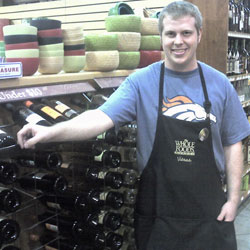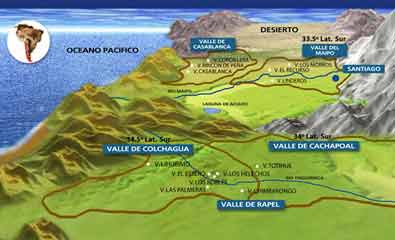
Marc, wine assistant at Whole Foods
I’m lurking in the $10-and-under section of the local Whole Foods grocery store (true to Wine News Review’s fairly frugal affordability index), thinking I’m in the mood for a certain Montepulciano. Don’t ask me why — at that place and point in time, I think it had something utterly to do with the name.
Say it. Let it roll over you tongue. Monte-pul-ciano. Ah, sweet, seems to almost transport you on wings of gossamer wine to that storied ridge of Monte Poliziano in Tuscany’s province of Sienna. (Read more about it here.)
Anyway, I’m admiring the lovely contours of a bottle of this particular product of that storied region, when Marc, the wine assistant, drops by to chitchat and we kick off a conversation about what he recommends. Right off the bat, he asks me if I’d like to try an organic wine.

Blog Action Day
Hmmm. Well, I certainly haven’t forgotten that I recently blogged about organic wines, on Blog Action Day 2007. So, yes, I say, I do like organic wines. He recommends an aptly named Natura Carmenere Valle Colchagua 2005, from Chile’s Emiliana vineyards, grown without the use of pesticides or chemicals.
Hmmm. I admire the bottle’s contours and abstractly artistic label, which advertises “notes of ripe cherries and plums.”
I read a little further. “Organic viticulture bring forth the true characters of the vineyard terroir and allows the grapes to express themselves fully.”
I’m sold.
After taking it home, I do a little research. The Colchaqua Valley, though not as storied as Monte Poliziano, is quite exotic in its own right, as the Emiliana website illustrates. Bounded by the Pacific Ocean to the west and the Andes Mountains to the east, the valley is caressed by an “extraordinary combination of maritime breezes and Andean winds.”
The result is delicious. Not only does the wine provide the advertised fruitiness, there’s a dry, rich, earthy complexity that, well, makes we want to take another sip, even as I type this thing.
Leslie Sbrocco at Wine Review Online seems to have had a similarly positive reaction. About the very same Natura Carmenere 2005, she writes: “An ideal wine to get acquainted with the beauty of Carmenere, Chile’s unique red grape. Most affordably priced versions can be too herbal and earthy, but this wine captures the spicy, dried herbal notes of Carmenere coupled with its sultry texture.”
Priced at around $10-12, the Emiliana Carmenere, Chardonnay, and Cabernet Sauvignon “bust the current belief that organically grown wines are pricey.”
So, thanks, Marc, for a fine recommendation. But truth be told, it wasn’t entirely his salesmanship (excellent though it was) that made me go organic rather than follow my Montepulciano inclination. I was primed, so to speak, by a column by the Dalai Lama in the local paper, The Washington Post, this past weekend.
No, Tenzin Gyatso, the spiritual leader of Tibet, doesn’t appear to be a drinking man. But something he said in that piece struck an organic note, and it may have had a bearing on my decision on what to buy:
The rapid changes in our attitude toward the Earth are also a source of hope. Until recently, we thoughtlessly consumed its resources as if there were no end to them. Now not only individuals but also governments are seeking a new ecological order. I often joke that the moon and stars look beautiful, but if any of us tried to live on them, we would be miserable. This blue planet of ours is the most delightful habitat we know. Its life is our life, its future our future. Now Mother Nature is telling us to cooperate. In the face of such global problems as the greenhouse effect and the deterioration of the ozone layer, individual organizations and single nations are helpless. Our mother is teaching us a lesson in universal responsibility.
Maybe you’re thinking, come on, vinothekid — what possible difference could the purchase of a single bottle of organic wine make?!
The Dalai Lama had a response to that. “Large human movements spring from individual human initiatives,” he wrote. “If you feel that you cannot have much of an effect, the next person may also become discouraged, and a great opportunity will have been lost.”
So there you have it. Oh, and one other thing, I’m adding organic wines to my listing of wine Bargains in the News (right column on the front page). As they say in Monte Poliziano, salute!



